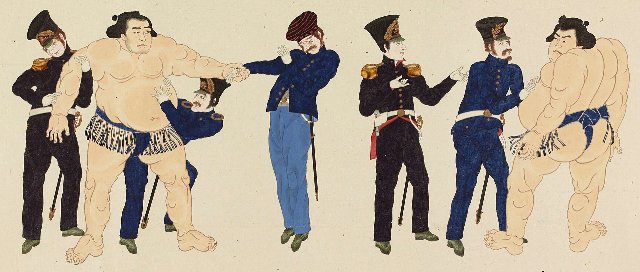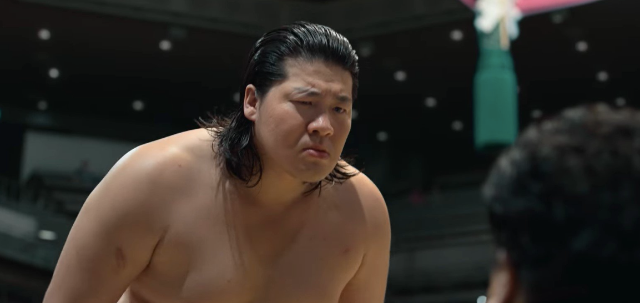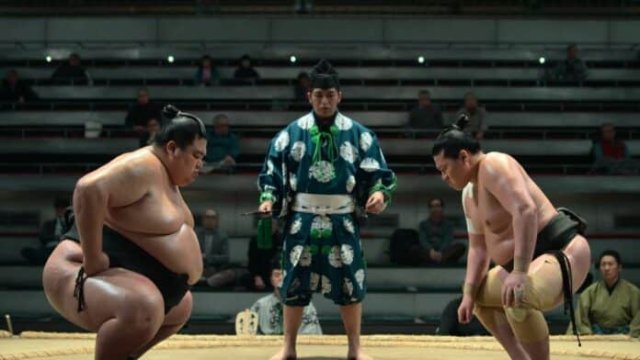Sanctuary on Netflix
SumoThrows Its Weight Around
By: Charles Giuliano - Nov 24, 2023
Like you, I knew nothing of Sumo the national sport exclusive to Japan.
Barefoot and naked, save for a traditional loin cloth, two men of varying degrees of immensity take crouching positions squaring off within a circle. The arena is layered with manicured soil which is blessed and sanctified with salt.
When both men’s clenched fists touch the ground the wrestlers lunge at each other. Matches, which mostly last for a few minutes, end when one of the opponents is pushed out of the circle or flung to the ground.
All of this is ruled by centuries of tradition and ritual. In recent years, however, the sport has been marred by scandal including matches fixed by Yakuza. There are also severe injuries resulting from dirty tricks including punches to the face and blows below the belt. Given the colossal weight of combatants the risk of injury is palpable.
I found myself riveted and binge watching eight episodes of Sanctuary a Netflix series.
Life as a wrestler is rigidly regimented, with rules regulated by the Japan Sumo Association. Most sumo wrestlers are required to live in communal sumo training stables, known in Japanese as heya, where all aspects of their daily lives—from meals to their manner of dress—are dictated by strict kyara tradition.
From an open casting call the project comprises a mix of professionals as well as actors who filled the body profile and were willing to undergo months of training. That results in a look of authenticity though to my untrained eye.
The series got off to a popular start, ranking first in Japan's "Today's Series TOP 10" for five days in a row, ranked 6th in Netflix's weekly global TOP 10 (non-English series), and was ranked #1 in "Today's Series" in more than 50 countries and regions around the world. Reviews were mixed but generally concede that while flawed the series is entertaining.
The title Sancuary is a reference to heya a refuge where wrestlers live and train communally. The show stars Wataru Ichinose in the role of Kiyoshi Oze, an outspoken and violent young man who joins the world of professional sumo under the shikona, or ring name, Enno for the sake of money.
He is a raw and talented delinquent with no future other than embracing a sport for which he has no respect. As he succeeds in climbing the ladder of the sport he does so in a flamboyant and thuggish manner that attracts scorn and censure of those who govern the sport.
There is a comical subplot revealing the corruption and manipulation of those who govern the sport. Having been harassed by them there is a comical scene where Hanno hurls an opponent as well as himself onto a taunting official seated ringside. Regaining his feet Hanno pointedly steps on the official’s face.
This big, violent lug is desperate to earn money to pay for the costly life support of his father. The family fell on hard times when their sushi restaurant went belly up. His mother is a whoring, vile, harridan who taunts her son to pay the family bills.
Enno is a complex but mostly sympathetic character whose brutal training and harassment provide a way into understanding and appreciating the sport.
Another trope is Shioli Kutsuna as Asuka Kunishima, a progressive journalist who grew up abroad and finds herself transferred from the political department to write a feature on sumo. Initially she is indifferent and scornful. Sumo restricts women and she battles back. It is most unusual that she has intimate access to her subjects. She comes to differentiate and care deeply for them, particularly Hanno.
The “stable” is presided over by a stern but caring Pierre Taki as Ensho-oyakata, a toshiyori who used to be a wrestler under the name Enfu. He recruited Kiyoshi within his stable after he saw his talent during a judo competition. The coach/ manager is a sumo elder of the Japan Sumo Association (JSA). Also known as oyakata, former wrestlers who reached a sufficiently high rank are the only people eligible. The benefits are considerable, as only toshiyori are allowed to run and coach sumo stables.
While there are multiple at times confusing sub plots and back stories the series pulls us in during brutal and harsh training sessions and competition during multi-day tournaments.
Since 1958, six Grand Sumo tournaments or honbasho have been held each year: three at the Kokugikan in Tokyo (January, May, and September), and one each in Osaka (March), Nagoya (July), and Fukuoka (November). Each tournament begins on a Sunday and runs for 15 days, ending also on a Sunday. The tournaments are organized in a manner akin to a McMahon system tournament; each wrestler in the top two divisions (sekitori) has one match per day, while the lower-ranked wrestlers compete in seven bouts, about one every two days.
Each day is structured so that the highest-ranked contestants compete at the end of the day. Thus, wrestling starts in the morning with the jonokuchi wrestlers and ends at around six o'clock in the evening with bouts involving the yokozuna. The wrestler who wins the most matches over the 15 days wins the tournament championship for his division. If two wrestlers are tied for the top, they wrestle each other and the winner takes the title.
Depending on the rank they have earned, and that of their opponent, winners earn prize money. With tournaments on television there is a vast market for the sport and related gambling. Top athletes have the status of movie stars as we see them swarmed by fans.
Defying all rules and traditions Enno is on track for fame and fortune. We wince as the vultures swoop in taking advantage of his ignorance and innocence. A big busted bar girl bilks and cons him. While he lavishes her with gifts she fends him off as a lover.
Despite the pathetic diversions of clubs and drinking the real focus of the series is on training. During one raucous night out, when Hanno is teased into a karaoke spectacle, he is hung over and in no shape for training.
There is systemic abuse. The established wrestlers haze and beat on rookies and those of lower rank. Getting by on raw talent Hanno is taunted that he will never achieve higher rank unless he truly embraces and has a passion for sumo.
This comes to a head when he is matched against the mammoth Shizuuchi. This blimp of a man, roughly twice the size of Hanno, is his nemesis. When they meet both are defending lengthy undefeated streaks. With multiple blows to the face, and an ear ripped off, Hanno is raced to the hospital for a long recovery and tentative return to the sport.
During a return to training he has lost his nerve. That changes slowly as he beomes obsessed and passionate about sumo with a commitment for revenge.
As a child his rival, Shizuuchi, witnessed the suicide of his mother after she killed his brother. This looms over his character and signifies his deadly gladiator stance in the ring. There is another side to him as a hulking innocent. We find him transfixed under cherry blossoms.
The series ends with their duel to the death rematch. In a cliffhanger manner we see them lunge then the screen goes black.
At the conclusion of this series, which has elements of outrageous black humor, I was fascinated by these obese athletes and their lifestyle. We see them consuming enormous amounts of food and drink to put on weight. Sumo wrestlers often die in their 60s or 20 years younger than average Japanese males. They suffer from diabetes and heart disease.
That’s a terrible price to pay in order to excel at a sport.




